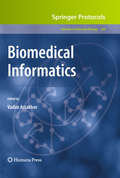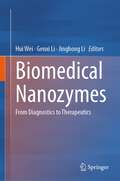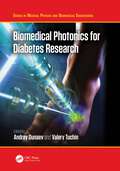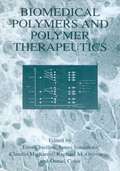- Table View
- List View
Biomedical Implants: Materials, Design, and Manufacturing
by Ravi K. Dwivedi, Premanand S. Chauhan, Avadesh K. Sharma, Madhavi Singh, and Anupma AgarwalThis book provides a comprehensive overview of the development of implants, from the selection of materials to the outcome of the process. It covers various steps, including biocompatible material, synthesis, and characterization, compatibility and limitations of materials, specific implants, and finite element analysis of medical implants. It also presents a comparison between predictions and experimental results by studying real-world problems and addresses the issue of sustainability in implant manufacturing, process modeling, and optimization in additive manufacturing supported by case studies. Features:• Covers the development of implants from the selection of material to the suitable process of manufacturing technologies.• Includes biocompatible material, synthesis, characterization, compatibility, and limitations of materials.• Reviews biofabrication in terms of artificial organs and soft tissues.• Discusses implant manufacturing, including additive and micro-manufacturing and failure analysis through case studies.• Addresses the issue of sustainability in implant manufacturing. This book is intended for researchers and graduate students specializing in mechanical, biomedical, healthcare engineering, biomaterials, and additive manufacturing.
Biomedical Implants: Materials, Design, and Manufacturing
This book provides a comprehensive overview of the development of implants, from the selection of materials to the outcome of the process. It covers various steps, including biocompatible material, synthesis, and characterization, compatibility and limitations of materials, specific implants, and finite element analysis of medical implants. It also presents a comparison between predictions and experimental results by studying real-world problems and addresses the issue of sustainability in implant manufacturing, process modeling, and optimization in additive manufacturing supported by case studies. Features:• Covers the development of implants from the selection of material to the suitable process of manufacturing technologies.• Includes biocompatible material, synthesis, characterization, compatibility, and limitations of materials.• Reviews biofabrication in terms of artificial organs and soft tissues.• Discusses implant manufacturing, including additive and micro-manufacturing and failure analysis through case studies.• Addresses the issue of sustainability in implant manufacturing. This book is intended for researchers and graduate students specializing in mechanical, biomedical, healthcare engineering, biomaterials, and additive manufacturing.
Biomedical Informatics (Methods in Molecular Biology #569)
by Vadim AstakhovIn past decades, the area of bioinformatics has proved to be both dynamic and vital, producing a wide spectrum of novel approaches and assuming an increasingly important role in modern bio-technological development. In Biomedical Informatics, expert researchers explore cutting-edge new advances in the field, providing an overview of novel cyberinfrastructures which are currently under development in various bio-medical centers across the world. Chapters demonstrate various architectures for large-scale collaboration, offer modern approaches currently used in various areas of bioinformatics, and highlight the software challenges associated with large-scale biomedical informatics. Composed in the highly successful Methods in Molecular Biology™ series format, chapters include a brief introduction, detailed methods, and a Notes section which shares tips on troubleshooting and avoiding known pitfalls. Wide-ranging and innovative, Biomedical Informatics is an essential manual for newcomers to this area, as well as an invaluable addition to the laboratories and offices of the most practiced researchers.
Biomedical Informatics: Discovering Knowledge in Big Data (Lecture Notes in Computer Science #8401)
by Andreas HolzingerThis book provides a broad overview of the topic Bioinformatics with focus on data, information and knowledge. From data acquisition and storage to visualization, ranging through privacy, regulatory and other practical and theoretical topics, the author touches several fundamental aspects of the innovative interface between Medical and Technology domains that is Biomedical Informatics. Each chapter starts by providing a useful inventory of definitions and commonly used acronyms for each topic and throughout the text, the reader finds several real-world examples, methodologies and ideas that complement the technical and theoretical background. This new edition includes new sections at the end of each chapter, called "future outlook and research avenues," providing pointers to future challenges. At the beginning of each chapter a new section called "key problems", has been added, where the author discusses possible traps and unsolvable or major problems.
Biomedical Informatics: Computer Applications in Health Care and Biomedicine (Health Informatics)
by Edward H. Shortliffe James J. CiminoThis book focuses on the role of computers in the provision of medical services. It provides both a conceptual framework and a practical approach for the implementation and management of IT used to improve the delivery of health care. Inspired by a Stanford University training program, it fills the need for a high quality text in computers and medicine. It meets the growing demand by practitioners, researchers, and students for a comprehensive introduction to key topics in the field. Completely revised and expanded, this work includes several new chapters filled with brand new material.
The Biomedical Laser: Technology and Clinical Applications
by Leon GoldmanThe laser's range of application is extraordinary. Arthur Schawlow says, "What instrument can shuck a bucket of oysters, correct typing errors, fuse atoms, lay a straight line for a garden bed, repair detached retinas, and drill holes in dia monds?"O The laser's specifically biomedical uses cover a similarly broad and interesting spectrum. In this book, I have endeavored to convey some of the fas cination that the laser has long held for me. It is my hope that both clinicians and researchers in the various medical and surgical specialties will find the book a use ful introduction. Biologists, particularly molecular biologists, should also find a great deal of relevant information herein. This volume's distinguished contributors provide admirably lucid discussions of laser principles, instrumentation, and current practice in their respective special ties. Safety, design, capabilities, and costs of various lasers are also reviewed. We have aimed to create a practical text that is comprehensive but not exhaustive. Our emphasis on the practical, rather than the esoteric, is dictated not only by the short history of biomedical laser use, but by the extent of the community to which this information will appeal.
Biomedical Mass Transport and Chemical Reaction: Physicochemical Principles and Mathematical Modeling
by James S. Ultman Harihara Baskaran Gerald M. SaidelTeaches the fundamentals of mass transport with a unique approach emphasizing engineering principles in a biomedical environment Includes a basic review of physiology, chemical thermodynamics, chemical kinetics, mass transport, fluid mechanics and relevant mathematical methods Teaches engineering principles and mathematical modelling useful in the broad range of problems that students will encounter in their academic programs as well as later on in their careers Illustrates principles with examples taken from physiology and medicine or with design problems involving biomedical devices Stresses the simplification of problem formulations based on key geometric and functional features that permit practical analyses of biomedical applications Offers a web site of homework problems associated with each chapter and solutions available to instructors Homework problems related to each chapter are available from a supplementary website (<http://engineering.case.edu/BMTR). These problems provide practice in basic computations, model development, and simulations using analytical and numerical methods.
Biomedical Mass Transport and Chemical Reaction: Physicochemical Principles and Mathematical Modeling
by James S. Ultman Harihara Baskaran Gerald M. SaidelTeaches the fundamentals of mass transport with a unique approach emphasizing engineering principles in a biomedical environment Includes a basic review of physiology, chemical thermodynamics, chemical kinetics, mass transport, fluid mechanics and relevant mathematical methods Teaches engineering principles and mathematical modelling useful in the broad range of problems that students will encounter in their academic programs as well as later on in their careers Illustrates principles with examples taken from physiology and medicine or with design problems involving biomedical devices Stresses the simplification of problem formulations based on key geometric and functional features that permit practical analyses of biomedical applications Offers a web site of homework problems associated with each chapter and solutions available to instructors Homework problems related to each chapter are available from a supplementary website (<http://engineering.case.edu/BMTR). These problems provide practice in basic computations, model development, and simulations using analytical and numerical methods.
Biomedical Materials: Nanostructured Materials For Biomedical Applications (Mrs Proceedings Ser. #206)
by Roger NarayanThis second edition provides a comprehensive discussion of contemporary materials used in biomedical research and development. The pedagogical writing style and structure provides students with an understanding of the fundamental concepts necessary to pursue research and industrial work in this growing area of biomedical science, including characteristics of biomaterials, biological processes, biocompatibility, and applications of materials in implants and medical instruments. Written by leading researchers in the field, this volume highlights important topics associated with biomedical engineering, medicine and surgery. The revised text contains updates that reflect recent technological advances in biomedical materials. It contains information on new characterization methods and applications for biomedical materials and incorporates suggestions that were offered by readers and educators using the first edition over the years. This textbook takes the reader to the forefront of biomedical materials development, providing graduate students with a taste of how the field is changing, while also serving as a useful reference to physicians and engineers.
Biomedical Materials: Nanostructured Materials For Biomedical Applications (Mrs Proceedings Ser. #206)
by Roger NarayanBiomedical Materials provides a comprehensive discussion of contemporary biomaterials research and development. Highlighting important topics associated with Engineering, Medicine and Surgery, this volume reaches a wide scope of professionals, researchers and graduate students involved with biomaterials. A pedagogical writing style and structure provides readers with an understanding of the fundamental concepts necessary to pursue research and industrial work on biomaterials, including characteristics of biomaterials, biological processes, biocompatibility, and applications of biomaterials in implants and medical instruments. Written by leading researchers in the field, this text book takes readers to the forefront of biomedical materials development, providing them with a taste of how the field is changing, while also serving as a useful reference to physicians and engineers.
Biomedical Modeling and Simulation on a PC: A Workbench for Physiology and Biomedical Engineering (Advances in Simulation #6)
by Rogier P. Van Wijk Van Brievingh Xun Shen Dietmar P. F. MöllerI have long had an interest in the life sciences, but have had few opportunities to indulge that interest in my professional activities. It has only been through simulation that those opportunities have arisen. Some of my most enjoyable classes were those I taught to students in the life sciences, where I attempted to show them the value of simulation to their discipline. That there is such a value cannot be questioned. Whether you are interested in population ecology, phar macokinetics, the cardiovascular system, or cell interaction, simulation can play a vital role in explaining the underlying processes and in enhancing our understanding of these processes. This book comprises an excellent collection of contributions, and clearly demonstrates the value of simulation in the particular areas of physiology and bioengineering. My main frustration when teaching these classes to people with little or no computer background was the lack of suitable simulation software. This di rectly inspired my own attempts at producing software usable by the computer novice. It is especially nice that software is available that enables readers to experience the examples in this book for themselves. I would like to congratulate and thank the editors, Rogier P. van Wijk van Brievingh and Dietmar P. P. Moller, for all of their excellent efforts. They should be proud of their achievement. This is the sixth volume in the Advances in Simulation series, and other volumes are in preparation.
Biomedical Nanomaterials: From design and synthesis to imaging, application and environmental impact
by Rostyslav S. StoikaThis book characterizes how to design and synthesize nanomaterials of an organic and mineral nature. The book also discusses the visualization of developed nanomaterials and their bio-applications, as well as describes the biomedical effects and environmental impact of nanomaterials. This is an ideal book for students studying biomedicine or the life sciences, as well as researchers and professionals in medicine, environmental protection, biotechnology, agriculture, and the food industry. More specifically, this book addresses the important nanomaterials and nanobiotechnologies that are used in those fields in biomedicine and life sciences.
Biomedical Nanotechnology: Methods and Protocols (Methods in Molecular Biology #726)
by Sarah J. HurstDue to their unique size-dependent properties, nanomaterials have the potential to revolutionize the detection, diagnosis, and treatment of disease by offering superior capabilities compared to conventionally-used materials. Biomedical Nanotechnology: Methods and Protocols brings together experts from a wide variety of fields to provide a practical overview of biomedical nanotechnology, from the conception of novel materials in the laboratory to the application of such structures in the clinic. After a brief introductory chapter, the first section consists of protocol chapters which provide hands-on information on the synthesis of a variety of solution-phase and surface-bound nanomaterials and their application in sensing, imaging, and/or therapeutics, while the second section consists of a series of case studies and review chapters that discuss the toxicology of nanomaterials, the regulatory pathways to US Food and Drug Administration (FDA) approval of these materials, their patenting, marketing, and commercialization, and the legal and ethical issues surrounding their use. Written in the highly successful Methods in Molecular Biology™ series format, many chapters include introductions to their respective topics, lists of the necessary materials, step-by-step, readily reproducible protocols, and insightful tips on troubleshooting and avoiding known pitfalls. Cutting-edge and authoritative, Biomedical Nanotechnology: Methods and Protocols surveys this exciting field from the most vital angles in order to provide a comprehensive reference for scientists and researchers of all different backgrounds looking to utilize the numerous versatile applications of nanomaterial technologies.
Biomedical Nanozymes: From Diagnostics to Therapeutics
by Hui Wei Genxi Li Jinghong LiThis book aims to summarize the latest research progress of biomedical nanozymes in diagnostic and therapeutic related fields. In terms of diagnostics, it will cover in vitro diagnostics, live analysis, and some emerging bioanalysis. In terms of therapeutics, it will introduce antioxidant therapy, peroxidation therapy and emerging therapy respectively. Furthermore, the research results previously scattered in many journals and conferences worldwide are methodically edited and presented in a unified form. Based on the new ideas and developments presented in this book, it will be of interest to readers from different areas, such as chemistry, materials, nanoscience and nanotechnology, biomedical and clinical studies, etc.
Biomedical Optical Sensors: Differentiators for Winning Technologies (Biological and Medical Physics, Biomedical Engineering)
by Richard De La Rue Hans Peter Herzig Martina GerkenThis book provides wide-ranging coverage of current developments in biomedical sensing based on photonic techniques. Biomedical sensing is a dynamic topic that promises to deliver much in the future evolution of medical diagnostics, delivering advanced tools for fundamental research in biology at the micrometre and nanometre scales. The book explores a variety of alternative physical and biological methodologies that have become available for application, such as plasmonic sensors and photonic crystal biosensors. At the same time, it addresses issues that potentially limit the capability of biomedical optical sensing techniques, while reviewing the state-of-the-art in biomedical optical sensing for the future work that will lead to near-universal applications of such techniques. Edited and written by leading experts in this domain, this book is ideal as a comprehensive manual for researchers and graduate students.
Biomedical Perspectives of Herbal Honey
by Rajesh Kumar Suresh Kumar Shamsher S KanwarThis book overviews honey and herbs that profoundly affect human metabolism when mixed in a balanced ratio. It covers various aspects of honey added to herbs and provides collective information and practical approaches regarding herbal honey and its applications as functional food and medicine. Honey has miraculous properties like anti-bacterial, anti-fungal, free radical scavenging, and anti-carcinogenic, so honey has tremendous therapeutic importance. Infusion of extract from various medicinal herbs in honey further modulates its therapeutic potential. This book provides all the information about the essentials of herbs-infused honey and its efficiency in fighting against pathogenic bacteria. It presents the significance and benefits of honey infused with herbs that may promote/boost immunity to fight contagious or non-contagious diseases. Not only does this book explain the comprehensive knowledge of herbal honey and its medicinal properties based on current researched evidence, but it also explores the contribution of herbal honey in the food science and medicine industry as a significant part of nutraceuticals and functional food research. By providing knowledge about the formulation of traditionally used herbs in combination with honey, scientific knowledge can be supplied and made available to the common public which shall probably be a real contribution to society.
Biomedical Photoacoustics
by Sihua YangAs a fast-growing imaging technology, photoacoustic (PA) imaging synergistically combines electromagnetic and ultrasonic waves providing higher contrast and resolution than conventional ultrasound imaging. This book presents the latest developments in this field, especially the advances in the detection of diseases using newly developed PA techniques.
Biomedical Photoacoustics
by Sihua Yang Da XingAs a fast-growing imaging technology, photoacoustic (PA) imaging synergistically combines electromagnetic and ultrasonic waves providing higher contrast and resolution than conventional ultrasound imaging. This book presents the latest developments in this field, especially the advances in the detection of diseases using newly developed PA techniques.
Biomedical Photonics for Diabetes Research (Series in Medical Physics and Biomedical Engineering)
by Andrey Dunaev Valery TuchinIn 2021, over 537 million people worldwide were diagnosed with diabetes, according to the International Diabetes Federation and so the diagnosis, care and treatment of patients with diabetes mellitus have become one of the highest healthcare priorities. Biomedical photonics methods have been found to significantly improve and assist in the diagnosis of various disorders and complications arising from diabetes. These methods have also been widely used in various studies in the field of diabetes, including in the assessment of biochemical characteristics, metabolic processes, and microcirculation that are impaired in this disease. This book provides an introduction to methods of biomedical photonics. The chapters, written by world-leading experts, cover a wide range of issues, including the theoretical basis of different biophotonics methods and practical issues concerning the conduction of experimental studies to diagnose disorders associated with diabetes. It provides a comprehensive summary of the recent advances in biomedical optics and photonics in the study of diabetes and related complications. This book will be of interest to biomedical physicists and researchers, in addition to practicing doctors and endocrinologists looking to explore new instrumental methods for monitoring the effectiveness of patient treatment. Features • The first collective book combining accumulated knowledge and experience in the field of diabetes research using biophotonics. • Contributions from leading experts in the field. • Combines the theoretical base of the described methods and approaches, as well as providing valuable practical guidance and the latest research from experimental studies.
Biomedical Photonics for Diabetes Research (Series in Medical Physics and Biomedical Engineering)
by Valery Tuchin Andrey V. DunaevIn 2021, over 537 million people worldwide were diagnosed with diabetes, according to the International Diabetes Federation and so the diagnosis, care and treatment of patients with diabetes mellitus have become one of the highest healthcare priorities. Biomedical photonics methods have been found to significantly improve and assist in the diagnosis of various disorders and complications arising from diabetes. These methods have also been widely used in various studies in the field of diabetes, including in the assessment of biochemical characteristics, metabolic processes, and microcirculation that are impaired in this disease. This book provides an introduction to methods of biomedical photonics. The chapters, written by world-leading experts, cover a wide range of issues, including the theoretical basis of different biophotonics methods and practical issues concerning the conduction of experimental studies to diagnose disorders associated with diabetes. It provides a comprehensive summary of the recent advances in biomedical optics and photonics in the study of diabetes and related complications. This book will be of interest to biomedical physicists and researchers, in addition to practicing doctors and endocrinologists looking to explore new instrumental methods for monitoring the effectiveness of patient treatment. Features • The first collective book combining accumulated knowledge and experience in the field of diabetes research using biophotonics. • Contributions from leading experts in the field. • Combines the theoretical base of the described methods and approaches, as well as providing valuable practical guidance and the latest research from experimental studies.
Biomedical Photonics Handbook, 3 Volume Set
by Tuan Vo-DinhShaped by Quantum Theory, Technology, and the Genomics RevolutionThe integration of photonics, electronics, biomaterials, and nanotechnology holds great promise for the future of medicine. This topic has recently experienced an explosive growth due to the noninvasive or minimally invasive nature and the cost-effectiveness of photonic modalities in
Biomedical Polymers: Synthesis and Processing (SpringerBriefs in Applied Sciences and Technology)
by Vinod B. Damodaran Divya Bhatnagar N. Sanjeeva MurthyThis book presents a comprehensive review on the various processing and post-processing methodologies for biodegradable polymers. Written by professionals with hands-on experience on polymer processing, this book provides first-hand knowledge of all contemporary processing techniques. The current status and future challenges in the field are described, as well as a framework for designing novel devices for desired applications.
Biomedical Polymers and Polymer Therapeutics
by DanielCohn Raphael M. Ottenbrite ClaudioMigliaresi JunzoSunamoto EmoChielliniProceedings of the Third International Symposium on Frontiers in Biomedical Polymers including Polymer Therapeutics: From Laboratory to Clinical Practice, held May 23-27, 1999, in Shiga, Japan. This book focuses on the progress and unique discoveries in the interdisciplinary scientific and technological area of biomedical application of polymers. The topics include polymeric materials for biomedical and pharmaceutical applications, as well as polymeric materials in therapeutics.
Biomedical Product Development: Bench to Bedside (Learning Materials in Biosciences)
by Babak Arjmand Moloud Payab Parisa GoodarziThis textbook covers all the steps in manufacturing a biomedical product from bench to bedside. It specifically focuses on quality assurance and management and explains the different good practice principles in the various phases of product development as well as how to fulfill them: Good laboratory practice, good manufacturing practice and good clinical practice. It provides readers with the know-how to design biomedical experiments to ensure quality and integrity, to plan and conduct standard preclinical studies and to assure the quality of the final manufactured biomedical products. Importantly, it also addresses ethical concerns and considerations.The book discusses the guidelines and ethical considerations for preclinical and clinical studies, to allow readers to identify safety concerns regarding biomedical products and to improve pre-clinical studies for the development of better products.This textbook is a valuable guide for biomedical students (B.Sc., M.S., and Ph.D. students) in the field of molecular medicine, medical biotechnology, stem cell research and related areas, as well as for professionals such as quality control staff, tissue bankers, policy-makers and health professionals.
Biomedical Research and Integrated Biobanking: An Innovative Paradigm For Heterogeneous Data Management (Springer Theses)
by Massimiliano IzzoThis doctoral thesis reports on an innovative data repository offering adaptive metadata management to maximise information sharing and comprehension in multidisciplinary and geographically distributed collaborations. It approaches metadata as a fluid, loosely structured and dynamical process rather than a fixed product, and describes the development of a novel data management platform based on a schemaless JSON data model, which represents the first fully JSON-based metadata repository designed for the biomedical sciences. Results obtained in various application scenarios (e.g. integrated biobanking, functional genomics and computational neuroscience) and corresponding performance tests are reported on in detail. Last but not least, the book offers a systematic overview of data platforms commonly used in the biomedical sciences, together with a fresh perspective on the role of and tools for data sharing and heterogeneous data integration in contemporary biomedical research.




















